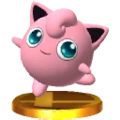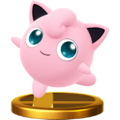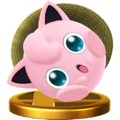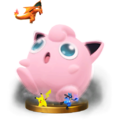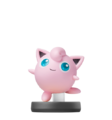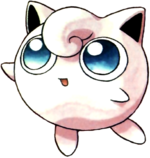Jigglypuff (SSB4)
| Jigglypuff in Super Smash Bros. 4 | |
|---|---|
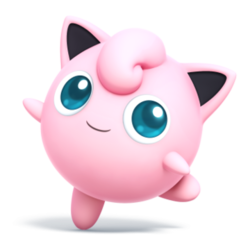 
| |
| Universe | Pokémon |
| Other playable appearances | in SSB in Melee in Brawl |
| Availability | Unlockable (3DS) Starter (Wii U) |
| Final Smash | Puff Up |
| Tier | H (58) |
Jigglypuff (プリン, Purin) is a playable character in Super Smash Bros. 4. It was formally added to the official website on November 5th, 2014, though the launch of Super Smash Bros. for Nintendo 3DS in Japan two months prior meant that its return to the series was already known. It was also seen several times during the Super Smash Bros. for Wii U: 50-Fact Extravaganza. Jigglypuff is once again voiced by Rachael Lillis in English and Mika Kanai in Japanese, albeit via recycled voice clips. As in previous games, it also has different voice actresses in French and German.
Jigglypuff holds the distinction of ranking 58th on the tier list, placing it at the absolute bottom of the cast. This is a very slight drop from its already very low placement in Brawl, where it ranked in the bottom tier at 36th out of 38. Jigglypuff retains its strong air game; it has nearly unrivaled aerial mobility thanks to its high air speed and multiple midair jumps, as well as good juggling ability thanks to its fast and long-lasting aerial attacks. All of these attributes facilitate a strong edgeguarding ability, and it can perform its signature Wall of Pain technique, albeit with less efficiency, and it has a potent finisher in its back aerial. Additionally, Rest has regained some of its power that was lost in Brawl.
However, Jigglypuff also retains its glaring weaknesses, as it still suffers from a very weak ground game due to its slow mobility, short reach, and lackluster grab game with no throw combos to speak of. Jigglypuff also has severe issues KOing, with laggy finishers and Rest being very difficult to land without a hard read. Its endurance is unarguably the worst, as it is extremely floaty and possesses the lowest weight stat in the game. While this does sometimes allow it to escape from what are usually true combos, this does not make up for the frailty that results from it. This is exacerbated by the new rage mechanic and weaker shields, the latter making its instant death shield jump even more dangerous.
Overall, Jigglypuff's weaknesses almost completely nullify its strengths, which has resulted in it remaining a bottom-tier character. When coupled with its lack of any buffs via patches, Jigglypuff has received virtually no tournament representation or results at high levels of play. However, it does have some positive results to its credit; Hungrybox, Serynder, and CrazieCuban have performed decently with it at regional tournaments, while LeeT notably placed 33rd at Shine 2016 while exclusively using Jigglypuff as a solo main.
How to unlock
In Super Smash Bros. for Nintendo 3DS:
- Collect 30 different equipment items.
- Play 120 VS Matches.
After completing one of the two methods, Jigglypuff must then be defeated on Unova Pokémon League.
Jigglypuff does not have to be unlocked in Super Smash Bros. for Wii U.
Attributes
Jigglypuff is a character of the extremes, as evident with its attributes: it has the second highest traction, the second fastest air speed, tied for the eleventh fastest air acceleration, the lowest falling speed, and the lowest gravity. These attributes make Jigglypuff a very mobile character in the air and give it easily controllable ground movement. However, it has the slowest walking speed and the second slowest dashing speed, the lightest weight and the lowest jump force, as well as a fairly slow jumpsquat. As such, these attributes make Jigglypuff unable to quickly traverse the stage on foot and susceptible to early KOs. To make up for its low jumping force, however, it has five midair jumps, which further enhance its aerial evasiveness. It's very low gravity also results in it taking slightly below average hitstun.
Jigglypuff's main strength is its formidable air game. Excluding back aerial, all of its aerial attacks have lingering hitboxes and, in the case of down aerial, multiple hits. Their duration is the primary reason Jigglypuff is deceptively difficult to challenge in the air, as opponents will most likely collide within an attack's final frames. All of its aerials, aside from its up aerial, also have enough range to be spaced correctly thanks to Jigglypuff's aerial mobility, allowing it to zone and approach opponents safely in the air. Each of Jigglypuff's aerials also have their own distinct strengths. Neutral aerial is its fastest aerial and one of the strongest sex kicks in the game, even when stale, and can easily gimp poor recoveries due to its late hitbox being sufficiently strong enough to do so. Due to its speed and power, it also works as a good out of shield or approach option. Forward aerial has the second weakest knockback of Jigglypuff's aerials, but this grants it good combo potential in return. It can also easily put opponents off-stage, and is the main component of the wall of pain technique: once an opponent with a poor recovery is sent off-stage, Jigglypuff can follow up with several other forward aerials until they reach the blast zone, from where Jigglypuff can finish the opponent off with another forward or a neutral aerial. Back aerial is Jigglypuff's strongest aerial, KOing reliably at 135%, and having a remarkable range, given Jigglypuff's small size. It is also safe on shield due to its high damage output and above average hitlag, though it is also its slowest aerial, making it a bit predictable. Up aerial has a deceptively long-lasting hitbox, which can be problematic for any opponent that has issues dealing with juggling. Lastly, down aerial can be used as a highly damaging out of shield or pressuring option, dealing up to 14% damage, and has low ending lag. It can sometimes also work as an anti-juggling option against characters with slow aerial mobility or moves.
Jigglypuff's unmatched floatiness, fast air speed, multiple jumps and strong aerial game also give it a tremendous off-stage presence. Due to lacking a traditional recovery move, its recovery is fairly susceptible to gimping, however, its other attributes make its recovery very solid regardless. Its fast air acceleration also allows it to disorient opponents that attempt to edgeguard it. With the aid of Pound, it can also stall its recovery and protect its landing. Jigglypuff is also fearsome at edgeguarding: with proper spacing and good timing, it can gimp all but the farthest reaching of recoveries without being put at risk; Cloud, Ness, Ganondorf, Dr. Mario and Little Mac are perhaps the most susceptible to its edgeguarding, as their recoveries lack both speed and resilience, while the latter four performances against Jigglypuff revolve around maintaining stage control most of the time.
Finally, Jigglypuff has a trump card in Rest, its signature move; it has very high vertical knockback at all percentages, to the point where it can reliably KO any character at 70%, but KOs most characters as early as 50%. It hits on frame 2 with a flower effect and has full invincibility until Jigglypuff closes its eyes. In addition to being an incredible punish, the threat of Rest forces opponents to have to be very careful when using laggy moves, and is made even scarier by Jigglypuff's ability to true combo into the move, though this is sometimes situational. The easiest way to confirm one is with forward aerial: hitting with the move's final frames will lead into an unavoidable Rest, which becomes even more potent if used in the air or with high rage. Depending on the opponent's falling speed, a jump may be necessary to reach them. Another reliable way to confirm one is by landing with up aerial: should Jigglypuff land immediately after hitting the opponent, Rest can be landed without fail. This combo works optimally on platforms due to its limited percentage range and its ability to KO as low as 35%. Up tilt can also lead into Rest, which can be used to rack up at least 30%, but opponents get sent too far away after low percentages. Finally, retreating with down aerial can also work, but aside from being the hardest to perform, it is also the least likely to succeed. Other methods of safely using Rest involve crouching, buffering, a footstool jump or interrupting an opposing neutral attack, though few characters are vulnerable to these methods, and they usually require impeccable timing. Platforms can be a saving grace when considering Rest, as they can lead into 0% kill-confirms on certain characters and, if they are moving, can make it a bit harder to punish. For all its potential, however, Rest has the slowest interruptibility in the game, allowing Jigglypuff to move only after five and a half seconds if the move is inputted, making it easy to punish, even if it kills the opponent, and thus being a gamble to attempt in almost any circumstance.
Jigglypuff is also held back by numerous severe weaknesses, which also create other kinds of noticeable flaws. The most detrimental is its survivability: Jigglypuff's stats result in it having the shortest endurance in the game. As a result, it can be knocked out as early as 40% with a sufficiently strong attack. The introduction of rage is an additional burden, since opponents can send it flying even earlier. These drawbacks force Jigglypuff to play extremely cautiously, as any damage taken can prove dangerous in the long run. Adding insult to injury, Jigglypuff's shield jump has enough force to KO it even from the very bottom of Palutena's Temple. This makes shielding very risky at low percentages, as the possibly survivable punishes normally received after a shield break are replaced by a guaranteed KO that can only be stopped by a ceiling.
Furthermore, Jigglypuff has a very problematic ground game. While most of its ground moves are fast in proportion to their power, its crippling lack of range and slow ground approach prevent it from racking up large amounts of damage with only a few moves. This is further worsened when considering the utility of its grounded attacks: neutral attack's incredible speed can lead into additional follow-ups, forward tilt is fast and highly damaging, up tilt can KO at unusually low percentages, and down tilt is a semi-spike with high base knockback. As for its smash attacks, forward smash has surprisingly high knockback scaling, while down smash has intangibility and the lowest launch angle of any other conventional semi-spike. Its grab game also has similar issues: while Jigglypuff has some of the fastest grabs in the game and the second most damaging set of throws (tied with Ganondorf and being surpassed only by Bowser), the former have very short range and the latter lack any follow-up or KO potentials, with its strongest throw, up throw, not being able to KO reliably even well beyond 200% [1]. This also results in Jigglypuff being easily kept at bay by shields without usage of Pound's high shield damage.
Jigglypuff's approach, despite being good in the air, is overall predictable and flawed. Most of the time, Jigglypuff might have to be close to the opponent, read its reaction in order to approach, or bait it in order to make its move. Its aerial moves are not good for approaching from a long distance as they are unsafe on shield when late, and its dash attack is terrible at doing so due to its long duration and despite its low cooldown. Coupled with the overall short range on its attacks, it is at a big disadvantage against characters with large disjoints like Marth, Shulk, and Cloud. Its polarizing mobility is also a noticeable flaw. Although it has among the greatest aerial games in SSB4, its ground movement is infamously one of the worst, as it does not efficiently give Jigglypuff the chance to traverse across the ground quickly like most other lightweight characters can, and in turn makes it very troubling on the offensive side of battle should it be going against speed-oriented characters, such as Sonic.
Additionally, all of Jigglypuff's specials are incredibly situational. Rollout is a chargeable attack that can KO incredibly early no matter where it is used, but is incredibly predictable and it's deceptively small hitbox results in it effectively having no priority, despite dealing 14% damage when fully charged. Sing has awkward timing, little range and does not work on aerial opponents, and despite not having a hitbox, can be countered. Its sleep effect can also be shortened with button mashing, reducing its otherwise devastating consequences. As a result, Jigglypuff has no reliable or safe recovery options, instead relying on its remaining jumps and Pound to recover, making it easy to gimp despite its usual off-stage comfort. Rest is very risky to use, and pound is slow and can't break shields that are on or near full health.
Lastly, Jigglypuff has among the least effective custom moves in the game, with only three having utility that overall surpass the default versions. Relentless Rollout has much less power, but is much faster, hits multiple times and pierces opponents, making it less punishable and allowing it to be used as a recovery mix-up. Pound Blitz is slower and less powerful, but can still pressure shields while hitting multiple times and granting more momentum. Hyper Voice is better for protecting Jigglypuff, since it deals reasonable knockback and works in the air. These benefits are marginal, however, and its other custom moves are disregarded in favor of the default versions due to their infamously low utility. Spinphony is arguably its worst custom move (and arguably the worst custom special move in the game), as it has very high startup, a very long interval between its active hitboxes and very long ending lag, to where one could use it from the upper blast zone of the stage, and be dragged down to the lower blast zone by the ending of the move, which are flaws that more than make up for the moves' utility at reversing opponents out.
Overall, Jigglypuff can rack up damage and KO opponents fast, but can be KO'd just as quickly. As a result of its very risky playstyle and mechanics, its popularity in competitive play still remains poor, as it has notoriously low tournament representation and almost no tournament results in singles at high levels of play. Even so, Jigglypuff has already received better representation and results than in Brawl, as it has more dedicated players, such as CrazieCuban, Hungrybox, RDR7, LeeT, and Serynder, who have performed decently at their local regionals. It should also be noted that Jigglypuff fares much better in doubles, as its combination of evasiveness and strength are well-suited to this environment courtesy of a teammate's attacks giving Jigglypuff many new options.
Changes from Brawl
Despite being ranked as the third worst character in Brawl, Jigglypuff has received a mix of buffs and nerfs (both directly and indirectly) in the transition to SSB4. However, even in spite of its powerful moves receiving even more strength, it was ultimately nerfed due to its most critical flaws from Brawl not being addressed, but rather worsened, while its few strengths (such as its air game and edgeguarding ability) have been nerfed.
Jigglypuff is, for the most part, adversely affected by universal gameplay changes. The removal of edge-hogging gives it a much harder time edgeguarding opponents, and while a number of characters have had their recoveries buffed, Jigglypuff's recovery was overall nerfed, as Pound grants less momentum than before. The addition of rage hinders its already poor endurance, and it usually cannot survive long enough to make effective use of the mechanic. The changes to shield mechanics further compound its frailty, as Jigglypuff's unusual shield jump is now a greater liability than in Brawl.
On the other hand, Jigglypuff benefits from the drastic changes to hitstun, as it is now able to perform true combos with its aerials again, although its air game has been nerfed: its up, down and back aerials (particularly the latter) have increased lag. Its forward aerial, which was a staple move in previous games, deals less damage and has much less knockback scaling, making it significantly less useful compared to what it was, while its lower short hop removes both its notable ability to use two aerials in one short hop. Due to this, a down aerial no longer autocancels out of a short hop, nerfing its approach. Its ground game was also weakened, as it no longer as access to its DACUS and its smash attacks deal less damage and knockback, with the reduction in endlag for its down and up smashes and its faster dashing speed failing to compensate for this well enough. Lastly, because of these changes, its KOing ability is thus worse, and even with the changes to hitstun allowing for some confirms into Rest, it still has difficulty landing said move.
However, Jigglypuff also received some buffs, most notably Rest's aforementioned power having been largely restored since Brawl, which also scales well with rage. Its neutral and back aerials have been buffed to KO at realistic percentages, at the cost of back aerial's noticeable speed loss due to it being repurposed as a KO move. A lot of its moves also have less lag, improving its approach and speed altogether, albeit for the exchange of less damage. Also, its dash attack is now able to block weak attacks, giving it both a new approach tactic and a way to deal with projectiles.
Despite these buffs, however, they do not properly compensate for the large nerfs it has received. As a result, it is one of the few characters to have been clearly nerfed in its transition from Brawl, alongside Meta Knight, Marth, Falco, Olimar and King Dedede. However, it is important to note several points: the former three characters (as well as several bottom tier characters like Charizard, Ganondorf and Zelda) have received buffs over game updates, whereas Jigglypuff has not. Despite the latter two characters not receiving noticeable buffs on game updates, their nerfs in the transition are not significant enough to worsen their respective standings among the SSB4 cast when compared to Jigglypuff's more critical flaws. The majority of the Brawl cast has also been buffed to varying degrees, most notably its fellow bottom-tiered characters, such as Mario and Captain Falcon. Lastly, it doesn't really benefit from a slightly more favorable matchup spread due to certain dominant characters from Brawl, such as Meta Knight, being nerfed, as they still have clear strengths that Jigglypuff either lacks or said strengths get counterbalanced by its weaknesses, allowing those characters to overcome Jigglypuff. As such, Jigglypuff's standing among the rest of the cast is worse than in Brawl, which is reflected in its tier position and it once again lacking viability in competitive play.
Aesthetics
 Jigglypuff's design has undergone a few changes, much like the other playable Pokémon in SSB4. It now has smaller eyes, which are a brighter shade of cyan and farther apart from each other. Its mouth is also wider, positioned higher and stays closed as a smile, rather than being perpetually open. Additionally, Jigglypuff is also more expressive.
Jigglypuff's design has undergone a few changes, much like the other playable Pokémon in SSB4. It now has smaller eyes, which are a brighter shade of cyan and farther apart from each other. Its mouth is also wider, positioned higher and stays closed as a smile, rather than being perpetually open. Additionally, Jigglypuff is also more expressive.
Attributes
 Jigglypuff dashes faster (1.1 → 1.155).
Jigglypuff dashes faster (1.1 → 1.155). Jigglypuff's gravity is higher (0.05056 → 0.053088).
Jigglypuff's gravity is higher (0.05056 → 0.053088). Short hop is lower, which prevents Jigglypuff from performing two aerials from a short hop.
Short hop is lower, which prevents Jigglypuff from performing two aerials from a short hop. The general change in size between smaller and larger characters makes Jigglypuff's hurtbox smaller than in Brawl, which is especially noticeable among characters typically depicted as large or small in their respective series. However, this also hinders its range.
The general change in size between smaller and larger characters makes Jigglypuff's hurtbox smaller than in Brawl, which is especially noticeable among characters typically depicted as large or small in their respective series. However, this also hinders its range. The 19% damage increase to shields and the significant increase to shieldstun both significantly hinder Jigglypuff's survivability, due to its shield jump instantly ceiling KOing it.
The 19% damage increase to shields and the significant increase to shieldstun both significantly hinder Jigglypuff's survivability, due to its shield jump instantly ceiling KOing it. The removal of edge hogging and the introduction of edge trumping both hinder Jigglypuff's edgeguarding game.
The removal of edge hogging and the introduction of edge trumping both hinder Jigglypuff's edgeguarding game.
Ground attacks
 Neutral attack connects together better due to its new vertical trajectory.
Neutral attack connects together better due to its new vertical trajectory. Neutral attack can no longer jab reset, removing Jigglypuff's most reliable way to safely set up Rest or a charged smash attack from a missed tech. The second hit also has increased ending lag (11 frames → 14).
Neutral attack can no longer jab reset, removing Jigglypuff's most reliable way to safely set up Rest or a charged smash attack from a missed tech. The second hit also has increased ending lag (11 frames → 14). Dash attack no longer rebounds, which now makes it capable of blocking projectiles and most attacks. This improves its approach potential.
Dash attack no longer rebounds, which now makes it capable of blocking projectiles and most attacks. This improves its approach potential. All smash attacks deal less damage (16%/13% → 15%/12% (forward), 15%/13% → 14%/12% (up), 12% → 11% (down)). However, only forward smash's knockback scaling was compensated (103 → 115), while up and down smashes' were not (100 → 105 (up), 66 → 69 (down)), making them weaker as a result.
All smash attacks deal less damage (16%/13% → 15%/12% (forward), 15%/13% → 14%/12% (up), 12% → 11% (down)). However, only forward smash's knockback scaling was compensated (103 → 115), while up and down smashes' were not (100 → 105 (up), 66 → 69 (down)), making them weaker as a result. Up and down smashes have decreased ending lag (35 frames → 27 (up), 37 frames → 34 (down)).
Up and down smashes have decreased ending lag (35 frames → 27 (up), 37 frames → 34 (down)). The removal of DACUS slightly hinders Jigglypuff's already slow ground game due to making up smash more situational.
The removal of DACUS slightly hinders Jigglypuff's already slow ground game due to making up smash more situational.
Aerial attacks
 Neutral aerial deals 1% more damage (10% → 11%) and has increased knockback (20 (base)/90 (scaling) → 30/100), significantly improving its KO potential.
Neutral aerial deals 1% more damage (10% → 11%) and has increased knockback (20 (base)/90 (scaling) → 30/100), significantly improving its KO potential. Forward aerial deals less damage (12%/10% → 9%) and has decreased knockback scaling (108 → 98), significantly hindering its KO potential.
Forward aerial deals less damage (12%/10% → 9%) and has decreased knockback scaling (108 → 98), significantly hindering its KO potential. Forward aerial's decreased knockback scaling improves its combo potential, similarly to in Melee.
Forward aerial's decreased knockback scaling improves its combo potential, similarly to in Melee. Back aerial deals 1% more damage (12% → 13%) and has significantly increased knockback (0/10 (base)/90 (scaling) → 0/30/120), improving its KO potential.
Back aerial deals 1% more damage (12% → 13%) and has significantly increased knockback (0/10 (base)/90 (scaling) → 0/30/120), improving its KO potential. Back aerial has increased start-up (8 frames → 12), ending (20 frames → 27) and landing lag (15 frames → 18). It also has decreased active frames (4 frames → 2) and a slower autocancel window (frame 23 → 28). Altogether, these changes significantly hinder its spacing and Wall of Pain potentials.
Back aerial has increased start-up (8 frames → 12), ending (20 frames → 27) and landing lag (15 frames → 18). It also has decreased active frames (4 frames → 2) and a slower autocancel window (frame 23 → 28). Altogether, these changes significantly hinder its spacing and Wall of Pain potentials. Up aerial has increased active frames (9 frames → 13) and increased vertical range.
Up aerial has increased active frames (9 frames → 13) and increased vertical range. Up aerial has increased start up (8 frames → 9) and ending lag (16 frames → 24).
Up aerial has increased start up (8 frames → 9) and ending lag (16 frames → 24). Down aerial deals 2% less damage if all hits connect (16% → 14%). It also has increased start-up lag (frame 5 → 7) and no longer autocancels from a short hop.
Down aerial deals 2% less damage if all hits connect (16% → 14%). It also has increased start-up lag (frame 5 → 7) and no longer autocancels from a short hop. Down aerial is harder to SDI out of.
Down aerial is harder to SDI out of. Down aerial now launches opponents backward. This improves its edgeguarding potential and grants it new follow-up options, but removes some of its previous follow-up options.
Down aerial now launches opponents backward. This improves its edgeguarding potential and grants it new follow-up options, but removes some of its previous follow-up options. The changes to hitstun canceling improve Jigglypuff's aerial combo game.
The changes to hitstun canceling improve Jigglypuff's aerial combo game.
Throws/other attacks
 All grabs have decreased ending lag (23 frames → 20 (standing), 29 frames → 24 (dash), 25 frames → 22 (pivot)).
All grabs have decreased ending lag (23 frames → 20 (standing), 29 frames → 24 (dash), 25 frames → 22 (pivot)). Dash and pivot grabs have decreased start-up lag (frame 10-11 → 8-9 (dash), frame 10-11 → 9-10 (pivot)).
Dash and pivot grabs have decreased start-up lag (frame 10-11 → 8-9 (dash), frame 10-11 → 9-10 (pivot)). Pummel deals 0.1% more damage (3% → 3.1%) and is faster.
Pummel deals 0.1% more damage (3% → 3.1%) and is faster. Both floor attacks deal 1% more damage (6% → 7%).
Both floor attacks deal 1% more damage (6% → 7%).
Special moves
 Fully charged Rollout deals 4% less damage (18% → 14%) and has decreased knockback. Jigglypuff can also no longer move in midair after hitting an opponent, significantly hindering its recovery potential.
Fully charged Rollout deals 4% less damage (18% → 14%) and has decreased knockback. Jigglypuff can also no longer move in midair after hitting an opponent, significantly hindering its recovery potential. Rollout travels faster and deals more damage when traveling along slopes, such as on Green Hill Zone and Corneria. It can also bypass certain counterattacks.
Rollout travels faster and deals more damage when traveling along slopes, such as on Green Hill Zone and Corneria. It can also bypass certain counterattacks. Pound has decreased momentum, hindering its recovery potential.
Pound has decreased momentum, hindering its recovery potential. The 19% damage increase to shields benefits Pound, allowing it to break a shield that is below 70% of its health.
The 19% damage increase to shields benefits Pound, allowing it to break a shield that is below 70% of its health. Rest deals 5% more damage (15% → 20%), which largely restores its power from Melee despite having decreased knockback scaling (75 → 66). It also has a larger hitbox (2.6u → 3.4u) and has decreased ending lag (246 frames → 226), slightly improving its accuracy and safety.
Rest deals 5% more damage (15% → 20%), which largely restores its power from Melee despite having decreased knockback scaling (75 → 66). It also has a larger hitbox (2.6u → 3.4u) and has decreased ending lag (246 frames → 226), slightly improving its accuracy and safety. The implementation of blast KOs from the upper blast line hinders Rest's safety as a KOing option, due to it possibly allowing the opponent to respawn quickly and have a chance to punish Jigglypuff. However, the lengthening of screen KOs hinders an opponent's chance to punish Jigglypuff, as they now last just as long as star KOs.
The implementation of blast KOs from the upper blast line hinders Rest's safety as a KOing option, due to it possibly allowing the opponent to respawn quickly and have a chance to punish Jigglypuff. However, the lengthening of screen KOs hinders an opponent's chance to punish Jigglypuff, as they now last just as long as star KOs. Puff Up deals 1% less damage (18% → 17%).
Puff Up deals 1% less damage (18% → 17%). Puff Up significantly increases Jigglypuff's size, to the point that most stages are entirely covered, significantly increasing its reach.
Puff Up significantly increases Jigglypuff's size, to the point that most stages are entirely covered, significantly increasing its reach. Puff Up has received a solitary hitbox once Jigglypuff reaches its maximum size and cries, rather than using multiple hitboxes during the shrink that occurs following the cry. This new hitbox deals damage, reasonable knockback (depending on the opponent's damage) and launches at the Sakurai angle, rather than simply blowing the opponent away with a windbox (depending on their proximity to Jigglypuff's center mass). With the shrink hitboxes removed, Jigglypuff cannot chain hits against opponents trapped against a wall for massive damage and mounting knockback.
Puff Up has received a solitary hitbox once Jigglypuff reaches its maximum size and cries, rather than using multiple hitboxes during the shrink that occurs following the cry. This new hitbox deals damage, reasonable knockback (depending on the opponent's damage) and launches at the Sakurai angle, rather than simply blowing the opponent away with a windbox (depending on their proximity to Jigglypuff's center mass). With the shrink hitboxes removed, Jigglypuff cannot chain hits against opponents trapped against a wall for massive damage and mounting knockback. Puff Up's aesthetic visuals have changed. Jigglypuff's eyes continue to glow yellow from the Final Smash effect when performing Puff Up and it now makes the stage shake.
Puff Up's aesthetic visuals have changed. Jigglypuff's eyes continue to glow yellow from the Final Smash effect when performing Puff Up and it now makes the stage shake.
Update history
Jigglypuff is notorious for not receiving any direct changes despite being unilaterally considered a bottom-tier character. However, the changes to shield mechanics in updates 1.1.0 and 1.1.1 indirectly nerfed Jigglypuff, as the increased shieldstun makes its susceptibility to being instantly KO'd by having its shield broken more of a liability. Conversely, these changes also make Jigglypuff's attacks slightly safer on shield (most notably its back aerial) and benefits Pound's high shield damage output, slightly improving its limited approach. It also slightly benefits from the nerfs given to some of its hardest matchups in game updates, such as Diddy Kong, Sheik, Zero Suit Samus, and Bayonetta, however, it is the only bottom tier fighter to have never received a single buff, and as such, is currently considered the worst fighter in the game. Overall, Jigglypuff fares considerably worse relative to the cast than it did during the initial release, due to not receiving any truly significant changes from game updates.
 The instant reversal glitch of Rollout (by holding away while landing with Rollout when facing right) has been removed.
The instant reversal glitch of Rollout (by holding away while landing with Rollout when facing right) has been removed.
 This slightly hinders Rollout's utility.
This slightly hinders Rollout's utility.
 There was previously an issue where if Jigglypuff landed with rollout while facing left and holding away, Jigglypuff could not turn around at any point after landing with Rollout and the move lacked a hitbox. This was fixed.
There was previously an issue where if Jigglypuff landed with rollout while facing left and holding away, Jigglypuff could not turn around at any point after landing with Rollout and the move lacked a hitbox. This was fixed.
Moveset
| Name | Damage | Description | ||
|---|---|---|---|---|
| Neutral attack | 3% | Two alternating punches. It is very quick, which allows it to function as a pseudo-jab cancel into itself, forward tilt, down tilt, a grab or Pound. However, it is extremely short-ranged. | ||
| 3% | ||||
| Forward tilt | 10% | A spinning roundhouse kick. Due to it being short-ranged, it is best used as a follow-up from neutral attack. | ||
| Up tilt | 9% | A scorpion kick. Has some start-up, but is somewhat powerful for a tilt attack, as it begins KOing at 143%. Although it is best used for scoring KOs, it also possesses some combo potential similarly to Kirby's up tilt, though not to the same degree. It can combo into itself up to three times, a reversed forward tilt, an uncharged up smash, or a short hopped up aerial. However, these combos are only effective against heavyweights and fast-fallers beginning at 0% and up to 36%, with the first combo in particular only being effective against fast-fallers when it is used up to three times. While it can hit opponents in front of Jigglypuff, it has to practically touch them in order to land it. | ||
| Down tilt | 10% | A crouching shin kick. Can be used while crouching under some attacks, and has semi-spike knockback that is good for setting up edgeguards. | ||
| Dash attack | 12% | A lunging headbutt. Decently quick with good knockback for a dash attack and its hitbox blocks opposing attacks, although it is unsafe on hit at low percentages, and Jigglypuff's slow dashing speed somewhat limits its utility. Begins KOing at 129% when near the edge. | ||
| Forward smash | 15% (clean), 12% (late) | A thrust kick. Powerful, but has considerable ending lag. Begins KOing at 101% near the edge. | ||
| Up smash | 14% (clean), 12% (late) | An upward headbutt. Like up tilt, it is most effective if the opponent is behind Jigglypuff. Begins KOing at 131%. | ||
| Down smash | 11% | A spinning split kick. It is short-ranged, but is a semi-spike that deals horizontal knockback that can launch opponents sliding a long way across the stage. It can also hit below the edge, placing recovering opponents in a very vulnerable position. | ||
| Neutral aerial | 11% (clean), 6% (late) | A flying kick. It is a sex kick with a long-lasting late hitbox. One of Jigglypuff's best moves, as it is very safe and has decent knockback when sweetspotted. Commonly used to block opponents from the edge or to end a Wall of Pain. | ||
| Forward aerial | 9% (clean), 6% (late) | A dropkick. Somewhat weak knockback, but good for spacing and can be used for a Wall of Pain. Has a lingering hitbox, though it does not as last as long as neutral aerial's hitbox. Late hit can combo into Rest. | ||
| Back aerial | 13% | A spinning back kick. Jigglypuff's slowest aerial and lacks a lingering hitbox unlike its other aerials, but has strong knockback while still being reasonably quick, making it a potent finisher. Safe on shield if spaced properly. KOs at 120% near the edge. | ||
| Up aerial | 9% | Waves its arm in an overhead arcing motion. Very short range, but its hitbox lingers without losing strength. Good for juggling and sharking. Can combo into Rest at lower percentages, though this is quite situational. | ||
| Down aerial | 1.5% (hits 1-8), 2% (hit 9), 14% (all hits connect) | A diagonal corkscrew dropkick. Good out of shield option and somewhat effective as an anti-juggling option, but it is unsafe to land with due to its landing lag being punishable even on hit. With precise movement, a rising down aerial can combo into Rest. | ||
| Grab | — | Reaches out. Jigglypuff's overall grab range is the second shortest in the game, surpassed only by R.O.B.'s. However, each of its grabs has low ending lag. | ||
| Pummel | 3.1% | A slap. Its damage output and decent speed make it very effective, to the point that it is perceived as one of the best pummels in the game. | ||
| Forward throw | 5% (hit 1), 5% (throw) | Puffs up once to launch the opponent forward. Low knockback, but has low ending lag. | ||
| Back throw | 10% | A German suplex. Good for setting up edgeguards with its aerials. | ||
| Up throw | 10% | Spins once to fling the opponent upward. Jigglypuff's strongest throw, though it requires the use of stages with platforms and high rage to actually KO. | ||
| Down throw | 4% (hit 1), 6% (throw) | Pins the opponent to the ground and then rolls back and forth on their back, which launches them straight upward. | ||
| Forward roll Back roll Spot dodge Air dodge |
— | — | ||
| Techs | — | — | ||
| Floor attack (front) Floor getups (front) |
7% | Spins its legs around while getting up, kicking in front of itself and behind itself. | ||
| Floor attack (back) Floor getups (back) |
7% | Kicks in front of itself, then behind itself. | ||
| Floor attack (trip) Floor getups (trip) |
10% | Spins on the ground while kicking both sides, similarly to Captain Falcon's front floor attack. | ||
| Edge attack Edge getups |
6% | Performs a flip kick while climbing up onto the stage. | ||
| Neutral special | Default | Rollout | 14% (fully charged) | Rolls forward to slam into the opponent, similarly to Egg Roll. The move's power, range, and speed can be increased by holding the special button. When it is fully charged, Jigglypuff will giggle and briefly flash. Hitting a non-shielding opponent will cause Jigglypuff to rebound, which renders it unable to do anything else until it lands or is hit. This makes Rollout dangerous to use off-stage or at an edge, since the rebound will cause Jigglypuff to spin helplessly as it descends to the lower blast line. |
| Custom 1 | Relentless Rollout | 1%-2% (loop) | Charge time and travel speed are faster and it goes farther. The move does not end if it hits someone, instead rolling through them and dealing 1%-2% when fully charged for every time it makes contact. Much better for recovery than the default version. | |
| Custom 2 | Raging Rollout | 16% | The charge time is nearly twice that of the normal version and Jigglypuff cannot turn around, but Jigglypuff rolls faster and deals more knockback. This attack is also unblockable. High ending lag and meager horizontal distance make this custom move unsuited for recovery. | |
| Side special | Default | Pound | 11% | Rears its arm back and then throws a punch. Deals moderate knockback and its momentum moves Jigglypuff sideways, making it one of the two special moves it can use to recover. It also does a high amount of shield damage and has a surprisingly large, long-lasting hitbox. |
| Custom 1 | Sideways Pound | 7% | Launches opponents at a semi-spike angle, though it has weaker recovery momentum and a lower damage output. | |
| Custom 2 | Pound Blitz | 9% | Hits multiple times, granting it more power, shield damage and recovery momentum. However, it has a slightly lower damage output and much greater ending lag. | |
| Up special | Default | Sing | — | Sings its signature song, putting nearby opponents to sleep. The more damage they have taken, the longer they will sleep, making them susceptible to attacks, such as smash attacks or Rest. However, the song is short-ranged and makes Jigglypuff itself vulnerable to being attacked as well. Unlike typical up specials, Sing does not grant any vertical distance, resulting in it almost never being used in competitive play. |
| Custom 1 | Hyper Voice | 3% (hit 1-2), 5% (hit 3) | Sings a song that deals damage rather than putting opponents to sleep. The first sound wave causes opponents to flinch, whereas the second sound wave does not. The third sound wave has the most range as well as decent knockback. However, it is slower. | |
| Custom 2 | Spinphony | — (hit 1), 1% (hit 2), 2% (hit 3) | Deals damage and flips opponents, similarly to Mario's Cape. However, the flip effect only occurs if the opponent is facing Jigglypuff. Start-up and execution are extremely slow and unlike Hyper Voice, its first sound wave deals no damage at all. It is also ineffective at edgeguarding due to making opponents flinch, allowing them to use a second recovery move. | |
| Down special | Default | Rest | 20% (hit), 36% (flower effect) | Falls asleep. It has almost no start-up lag (1 frame) and deals an extreme amount of vertical knockback if landed, so much so that it KOs super heavyweights like Bowser at 61%. It also puts a flower on the opponent's head that deals continuous damage. However, if Rest misses, it has dire consequences, as Jigglypuff will be inactive for roughly 5 seconds until waking up or upon being attacked. It still has a chance to be punished if the opponent is blast KO'd at the upper blast line rather than Star KO'd or Screen KO'd, though they must be quick. Jigglypuff gains invincibility for a few frames when the move is used (before its eyes close) which can initially prevent counterattacks from hitting Jigglypuff, though this is not very useful due to the move's extreme ending lag. |
| Custom 1 | Leaping Rest | 11% | Leaps into the air while falling asleep. It has less strength, but has quicker start-up and can still reliably score KOs. Since Jigglypuff is sleeping, it cannot grab edges while jumping, making it ineffective at recovering. | |
| Custom 2 | Wakie Wakie | 14%-15% (explosion) | Pushes opponents back while sleeping and creates an explosion upon waking up. The move loses its tiny yet tremendously powerful hitbox at the start and inflicts 5% recoil damage, but Jigglypuff takes a shorter nap and the explosion deals 14%-15% flame damage. | |
| Final Smash | Puff Up | 17% | Rapidly inflates itself to a gargantuan size and launches all opponents near it horizontally while saying "Jiggly!" before quickly deflating back to its normal size. Jigglypuff's size is so great when inflating that its body completely takes up smaller stages and even some medium-sized ones, making this Final Smash nearly inescapable. | |
On-screen appearance
- Emerges from a Poké Ball and spins while floating before landing.
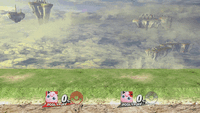
|
|---|
Taunts
- Up taunt: Happily spins in place on one foot, then looks and blinks at the camera while inflated, all while saying "Jigglypuff!" (プリプリーン!).
- Side taunt: Twirls around then poses while looking away at the opposite side it is facing, then blinks twice. This taunt is very similar to Kirby's side taunt.
- Down taunt: Deflates and falls to the ground, flattened, then quickly inflates again. While flattened, its hurtbox becomes significantly smaller. This taunt is similar to its fainting animation in home console Pokémon games, like Pokémon Battle Revolution.
| Up taunt | Side taunt | Down taunt |
|---|---|---|
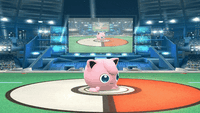
|
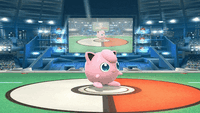
|
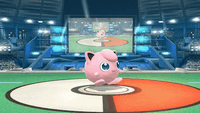
|
Idle Poses
- Looks at its side while jumping.
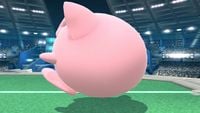
|
|---|
Crowd cheer
| English | Japanese | |
|---|---|---|
| Cheer | ||
| Description | Jigglypuff! | Pu-ri-n! |
| Pitch | Group chant | Female |
Victory poses
- Jumps twice, then does a backflip and looks toward the screen.
- Shivers while asleep and suddenly jumps up after awaking, rolling back and forth on its back.
- Uses Rest.
 |
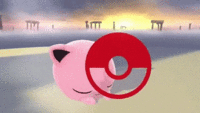 |
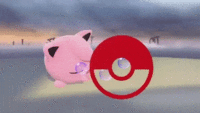
|
|---|
In competitive play
Official Custom Moveset Project
| Character | Custom sets available | ||||
|---|---|---|---|---|---|
| 1121 | 1122 | 1321 | 1322 | 2121 | |
| 2122 | 2321 | 2322 | 3121 | 1221 | |
Notable players
Active
Inactive
Tier placement and history
In the early metagame, it was widely considered that Jigglypuff was, at best, a mid-tier to low-tier character, and that Jigglypuff's buffs from Brawl would allow it to perform better in SSB4. However, its results and representation outside of doubles play were never as high as other characters that would rank above it in the future, and it would soon become clear that Jigglypuff had ironically lost much more than it gained in the transition. Despite the improved balancing of other characters, it infamously remained stagnant in game updates, with only a glitch that gave Rollout mindgame potential being fixed in 1.0.4. It would at rank 55th on the first tier list, one place near the bottom of the J tier. Jigglypuff continues to languish in the bottom tier, and due to still being unchanged positively by game updates while other bottom-tiered characters like Zelda and Ganondorf have received numerous buffs, it is currently ranked 58th on the second tier list, placing it at the very bottom of the H tier and the entire tier list itself.
Trophies
- Jigglypuff
This Normal- and Fairy-type Pokémon is best known for its soothing singing, which quite often puts foes to sleep. In this game, Jigglypuff fights best in the air, and can even jump six times in a row. The downside, though, is that Jigglypuff's so light, just about any opponent could launch it in their sleep!
- Jigglypuff (Alt.)
When you use the Rest down special, you go into a deep sleep, as you'd expect. But if anyone is touching you when you do it, you'll inflict a lot of damage and launch them directly upwards. They even continue to take damage afterwards. It's not easy to pull off, though, and falling asleep leaves you open to attacks, so be careful.
- Puff Up
When Jigglypuff uses its Final Smash, it starts to grow bigger. And bigger. And bigger! Before you know it, Jigglypuff will have completely taken over the screen-and there's no way to make it stop. On smaller stages, fighters may find there's nowhere left to stand! At near full size, Jigglypuff will damage and launch anyone it touches.
It doesn't deal a lot of damage or launch opponents a long way. No, when Jigglypuff uses its Final Smash, it gets...bigger. And bigger. And bigger. Before you know it, Jigglypuff will have completely taken over the screen - and there's no way to make it stop. On smaller stages, fighters may find there's nowhere left to stand!
- JigglypuffAllStarTrophy3DS.png
Alt. (3DS)
In Event Matches
Solo Events
- All-Star Battle: Secret: Jigglypuff is one of the opponents fought in this event. All opponents are characters that have been unlockable in previous Super Smash Bros. games.
- It's Past Your Bedtime!: Jigglypuff must use Sing to make Ness, Bowser Jr., and Toon Link fall asleep at the same time.
Co-op Events
- The Ultimate Battle: Two players select a character and must defeat the entire roster.
Alternate costumes

| |||||||

|

|

|

|

|

|

|

|
Gallery
Jigglypuff's amiibo.
Preparing to throw Captain Falcon.
Using Puff Up.
With R.O.B., Ness, and Pikachu.
Taunting while being spotted by 5-Volt on Gamer.
Trivia
- Super Smash Bros. for Wii U is the first installment where Jigglypuff is a starter character. As a result, Jigglypuff had appeared in various official screenshots and videos (such as the October 2014 Wii U Direct) without acknowledgement before its official reveal.
- Jigglypuff was the last character overall to be fully confirmed on the SSB4 website before the initial release of Super Smash Bros. for Wii U and, by extension, the last of the "perfect-attendance crew" to be announced.
- Jigglypuff's official artwork pose is a mirrored version of its pose from its official artwork from Pokémon Red and Green Versions. SSB4 is also the only Super Smash Bros. game to not have Jigglypuff fully face the screen in its official art.
- While Jigglypuff's textures are completely unique in Super Smash Bros. for Nintendo 3DS, its actual 3D model is very similar to its model used in Pokémon X and Y.[1]
- While most fighter trophies are sorted by debut appearance and then by unlockability within the type sorting, Jigglypuff is different in that it is placed between the Brawl characters and the SSB4 characters in the list.
- If done with correct timing, Jigglypuff can avoid damage by using its down taunt (many attacks can still hit it). Also, if its down taunt is used next to a cannon in the stage builder, Jigglypuff will be launched by said cannon.
- Jigglypuff is the only starter character in Super Smash Bros. for Wii U who has a challenge exclusive to it that cannot be unlocked with a Golden Hammer.
- Jigglypuff, Captain Falcon, and Yoshi are the only characters who have voice clips that are used in all five Super Smash Bros. games.
- Jigglypuff is also the only non-DLC character in SSB4 to have only one blast line KO voice clip.
- Ness and Jigglypuff are the only members of the "perfect-attendance crew" to not appear in any of the newcomers' poster art.
- Jigglypuff's grab uses part of Rollout's sound normally, In fact, if one uses 1/2x or 1/4x speed in SSB4 and uses Jigglypuff's grab, the Rollout sound will play until Jigglypuff finishes its grab. If the "Hold L" speeds are used, this will continue until time is unpaused.
References
| Fighters in Super Smash Bros. 4 | |
|---|---|
| Veterans | Bowser · Captain Falcon · Charizard · Diddy Kong · Donkey Kong · Dr. Mario · Falco · Fox · Ganondorf · Ike · Jigglypuff · King Dedede · Kirby · Link · Lucario · Lucas · Luigi · Mario · Marth · Meta Knight · Mewtwo · Mr. Game & Watch · Ness · Olimar · Peach · Pikachu · Pit · R.O.B. · Roy · Samus · Sheik · Sonic · Toon Link · Wario · Yoshi · Zelda · Zero Suit Samus |
| Newcomers | Bayonetta · Bowser Jr. · Cloud · Corrin · Dark Pit · Duck Hunt · Greninja · Little Mac · Lucina · Mega Man · Mii Fighter (Mii Brawler · Mii Gunner · Mii Swordfighter) · Pac-Man · Palutena · Robin · Rosalina & Luma · Ryu · Shulk · Villager · Wii Fit Trainer |
